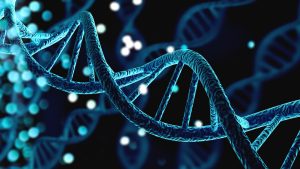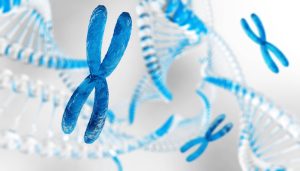Life on earth has various forms and unique features, and all the features are controlled by their unique genetic codes.
In a human cell, the genetic material is present in the form of double-stranded DNA molecules, forming the shape of a double helix. Genes, on the other hand, are part of DNA that can be translated to protein and gives us function. They are the basic physical and functional unit of heredity. Genes control most of our traits: skin and hair colour, ear shape, eye size, height and weight etc, together with environmental factors. Furthermore, genes are organized and packed into chromosomes and stored in the core of all body cells. Yes, it all sounds very confusing, let’s dive into it.
DNA

DNA, or deoxyribonucleic acid, is the hereditary material in humans and almost all other organisms. Each DNA molecule contains millions of nucleotides – the building blocks of DNA. There are four distinct types of nucleotides with different nitrogenous bases: adenine (A), guanine (G), cytosine (C), and thymine (T). As mentioned, DNA as a double-stranded molecule has its unique way of pairing. Each A nucleotide on a single strand could only match the T on the other strand, each G nucleotide could only pair the C nucleotide. The two strands are connected and paired by strong hydrogen bonding, which results in the eventual configuration of a double-stranded molecule.
DNA is present in all our body cells except red blood cells because it is in theory dead cell without a core nucleus, where most DNA molecules are stored. To make sure it can be present in all our body cells, DNA can replicate using the existing pieces of machinery in our body cells. Each strand of DNA in the double helix can serve as a pattern for duplicating the sequence of bases.
Gene
A gene is the basic physical and functional unit of heredity. It is a continuous sequence of DNA which act as instructions to make proteins. From 1990-2003, Human Genome Project sequenced all human genes and identified more than 20,000 different genes. Each gene is given a unique name for identification purposes.
We all have two copies of each gene, one inherited from each parent. As human beings, more than 99% of our genes are identical, only less than 1% difference determined our difference in look, shape, height etc. Meanwhile, we share 90% of our genes with a mouse and 96% with a monkey and chimp.
Some genes are not always actively translating themselves into proteins. Many are only activated by certain signals in our body when they are needed. For example, the genes that give inflammatory proteins only start to work when there’s an infection or abnormality in our body.
Chromosome

The double DNA molecule, along with the genes on them, pack themselves into X-shaped structures called chromosomes. Human beings have 46 chromosomes, with two of them controlling their gender. The Female has a XX sex chromosome whereas the male has an XY chromosome. The 46 chromosome comes in 23 pairs, with each pair having two chromosomes with identical shape.
In general, chromosomes are not visible under a microscope in the cell nucleus. However, during the replication process, the chromosomes condense and become visible for a short period. Figure 3 is a full picture of the human chromosome, the number is ranked based on the chromosome’s size.
From DNA to Traits
Now we have developed a basic idea of what our genetic material looks like. But how does it change from DNA molecules to proteins that dominate our traits, for example, skin colour?
When a certain protein is needed, DNA in the core of our body cells is first transcribed into RNA – ribonucleic acid. Different from DNA, RNA is made up of a single chain of nucleotides. It is subsequently transferred from the cell’s core to other pieces of machinery to go through a process known as translation, in which the RNA nucleotide sequence is read and then matched with its corresponding amino acid – the building block of protein.
Skin colour is a trait that is controlled by multiple genes. One of the proteins that give us skin colour is melatonin. After a few days of sun bath, you might develop a tan. That is because your skin needs darker colour to protect against UV damage. During sun baths, the genes that control the expression of melatonin protein are activated and produce large amounts of melatonin. After staying indoors for a month, your tan might fade, as you no longer need that much melatonin.
Conclusion
Since the discovery of DNA in 1953 by American biologists James Watson and Francis Crick, we have made huge scientific and technological advancements in terms of our understanding of genetic materials. Now in the 21st century, we can use genetic engineering technology to identify, target and modify genes freely. However, there has been an ongoing debate over the past decades on to what extent should we be allowed to modify the genes in human cells and other organisms. Legislations in many jurisdictions could not catch up with the speed of technological advancement. It’s up to the scientists and the next generation of talents to use the technology responsibly and benefit us all.











